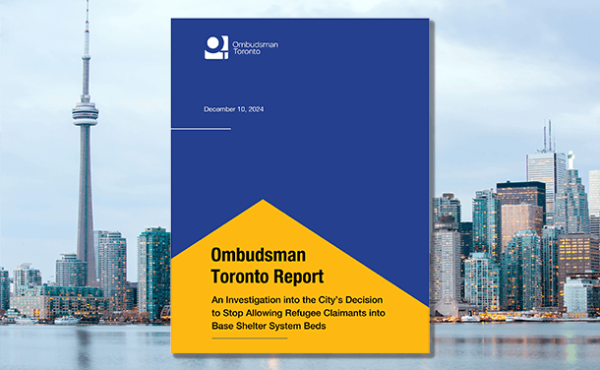
Cross-posted from Eye Weekly.
OK, so maybe not everyone has gotten the message, but over the past 15 years or so (or perhaps more, depending on your social circle and reading habits) scientists, environmentalists and a host of other forward-thinking advocates have been telling us: we have to fight climate change; the consequences will be disastrous; we must do everything we can to stop it.
After too many years of too little to late, the message has changed somewhat. We still have to fight climate change, but we also have to recognize that global warming is already upon us. And while we need to work to prevent it from getting worse (or more optimistically, reverse its effects), we also have to work to ensure we are prepared to deal with the consequences of a warmer climate.
Is the City of Toronto ready to adapt to a new normal of increased floods and droughts, new pests and vector-borne illnesses, and a possible influx of environmental refugees? After sitting in on a series of presentations on climate change adaptation given to the Parks and Environment Committee yesterday, I can tell you that the answer to this question is a resounding “no.” Toronto may have a plan to help mitigate climate change, but there’s no plan for how the city will adapt to it, and the consequences of that could mean severe economic, social and health problems in the years to come.
“Adaptation should be the new buzzword that defines how we move forward with standards,†Councillor Adam Vaughan insisted after listening to the speakers. One of the biggest and perhaps most expensive hurdles that the city will have to overcome is how to update its infrastructure, which, climate change aside, has already received its fair share of time in the spotlight in recent months thanks to a nationwide $123 billion backlog in state of good repair. On top of replacing our aging roads, pipes and bridges and making sure they are well-maintained, the city will also have to make sure they are solid enough to handle things such as more severe floods. Add this to the already long list of stressors on Toronto’s budget.
“We need to be ready for more severe weather more frequently, which means greater risks due to weather-related events than we have ever faced before,†said Mark Yakabuski, president of the Insurance Bureau of Canada. Yakabuski may seem like an unlikely spokesperson for the struggle over climate change, until you realize that his whole job deals with assessing risks. The ice storm that took place in Ontario and Quebec in 1998 consumed 20 per cent of all premiums paid for by property insurance in Canada for that year, he told the committee. Overall, he said, 93 per cent of all major catastrophes are weather-related.
“It is not good enough to simply say we’ll maintain pieces of infrastructure at the standard for which they were built. It’s not going to be adequate,†argued Yakabuski. “We need to rebuild our infrastructure at a significantly higher standard in order to try to deal with a threat that’s higher than we’ve ever faced before. We have to review building codes and be as strict as possible in enforcing land use decisions. We don’t have the luxury to take our time to get it done. We need to find innovative ways to fund these investments now.â€
Yakabuski’s comments set off a light bulb in Adam Vaughan’s head. “I’m wondering if there’s a way to tie the high threat of premiums to low infrastructure investment to try to get the message across… to say to Ottawa, ‘Look, the industrial heartland of this country is going to be wiped out through insurance premiums if you don’t put the investment into the infrastructure,’†he said. “In other words, if Toronto doesn’t receive sufficient funds from Ottawa and Queen’s Park, there will be a quid pro quo increase in insurance premiums and that will affect the private sector’s bottom line.â€
Updating our infrastructure, however, is just one of the challenges that lies ahead. Dr. Monica Campbell, manager for Toronto Public Health, spoke about preparing for heat waves like the one in Europe in 2003 that killed nearly 70,000 people. In Toronto, heat-related mortality will double by 2050 and triple by 2080, she said. Furthermore, air pollution mortality will increase by 20 per cent by 2050 and 25 per cent by 2080. Campbell also reminded the committee that vulnerable populations are more likely to be negatively affected by climate change. In California, she said, research has been conducted to construct a Social Vulnerability Index to help ensure these populations don’t get left behind.
Councillor and long-time environmental activist Gord Perks was happy to hear these sorts of social issues addressed. “The easy temptation is to understand this as a mechanical, a physical problem, something that has to be dealt with in terms of building code standards, road standards and physical infrastructure. There are deeper and more complex issues at stake,†he said. “We have now hit the point that the number of refugees from ecological causes is greater than that from war, and that will grow. I don’t know how Toronto is preparing itself to deal with an even larger global refugee problem. We do our share now; there are arguments that we don’t do it well enough, but clearly it’s a piece of our climate change adaptation strategy.â€
So where do we go from here? The city has plans to develop an “adaptation strategy framework document,†and will be looking for the public to comment on it in May. For a full list of yesterday’s presenters and links to their presentations, visit the “climate change adaptation†page recently created on the city’s website.

